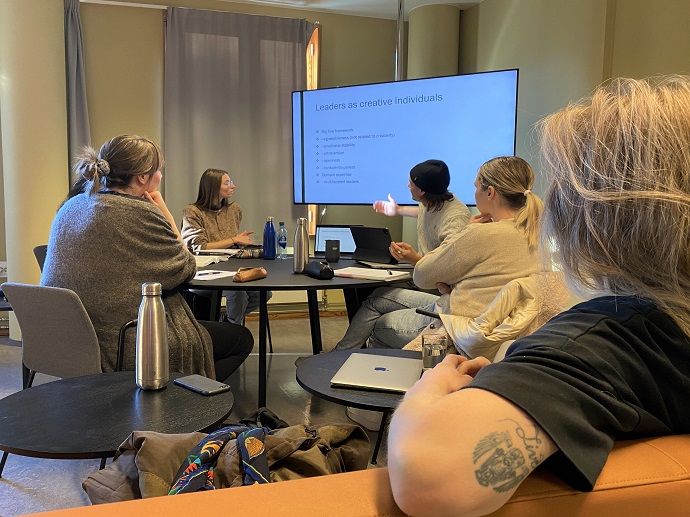Written by: Professor Palmyre Pierroux & Postdoc Morgane B. Domanchin (IPED)
Space matters
As teachers in a higher education institution, we prepare lectures, materials and course activities with knowledge about how university students learn. At IPED, this means designing courses for students’ active participation, with opportunities to contribute and discuss in small group or whole class activities. Yet too often, walking into university classrooms or auditoriums to teach has involved little time or opportunity to reflect on how the space, furniture, lighting, screens and technologies might best be arranged to support our different pedagogical intentions. Research on university learning environments has shown that ‘space matters’ but points to the need for further studies to understand how the social and material features of classrooms are intertwined with learning processes. The COVID pandemic was also an important intervention, challenging us to reflect on teaching and active learning practices in new physical, virtual and hybrid contexts.
Room to experiment
Providing opportunities for educators and students to take on this challenge was an important part of the physical and technical upgrades that were made in Helga Engs Hus in 2021 during the pandemic. In particular, Rooms 241 and U39 were planned as spaces for pedagogical innovation, inviting teaching staff and students to experiment with arrangements of furnishings and technologies and to reflect on how these supported different learning activities and teaching intentions. Room 241 is a large space that introduced several new elements into UV's and UiO's classroom environments: movable walls, multiple wall projections, and informal zones such as sofas and high stool seating.

Students as co-inquirers
In fall 2022, supported by IDEA, students in the master course PED 4501 (Learning, creativity and innovation) were invited at the start of the semester to participate in a pilot study of Room 241 as part of the course activities. Specifically, they were invited to participate as co-designers and co-inquirers to explore the question: How can a newly designed classroom function as a resource for student-centered learning approaches? We discussed the possible delays, inconveniences and stress that would likely be involved in moving furniture around and figuring out how to use new technologies, but we all agreed to be patient with each other – especially with the teachers! We collected data in the form of observations and notes, photos, and ongoing evaluation of the use of the room, both formative and summative (Mentimeter, postits, discussion, reflection papers, and technical ‘checklist’ suggestions).
Principles and (new) practices
The overall pedagogical principles for the course activities were to facilitate dialogue (group and whole class), shared visualizations and different forms of peer-to-peer and group collaboration. A concrete outcome of the pilot study was arrangements of resources and the physical space that supported five distinct types of student-centered learning in the course PED 4501. Another, less concrete outcome was learning together about the value – and fun! - of co-designing and co-researching how we used our teaching and learning space.
While this was just a small study, it provided some guidelines for how space and resources in Room 241 can be arranged to support different pedagogical designs. It has also provided insight into how students and teachers can collaborate to shape our educational experiences. This fall, we have applied the guidelines for a new semester of PED 4501. We are thrilled to discover that our engagement as teachers in arranging and using the potential of the space has been enthusiastically adopted by the new students, unprompted - as a matter of practice. For this we thank the ‘KDL’ and international students who contributed to this study while taking PED 4501 last fall!
Nysgjerrig på mer om hvordan utforming av campus spiller inn på læring, trivsel og samarbeid? Du kan lese mer i rapporten til Lillejord et al. (2017).
Mer om IDEA UndervisningsPuls...
UndervisningsPuls er en artikkelserie av og for undervisere ved UV-fakultetet på Universitetet i Oslo, publisert av IDEA Innovasjon og digitalisering i utdanning, i forbindelse med våre aktiviteter.
Vi har også en tilsvarende artikkelserie for studenter: IDEA StudentPuls.
Vi tar gjerne imot forslag og tekster fra undervisere som ønsker å bidra, så ta kontakt via kontakt-idea@uv.uio.no for å bli tildelt en artikkelmal om du har noe du vil dele.